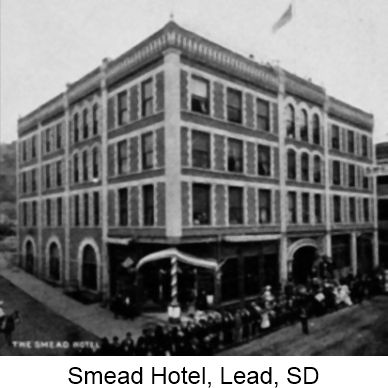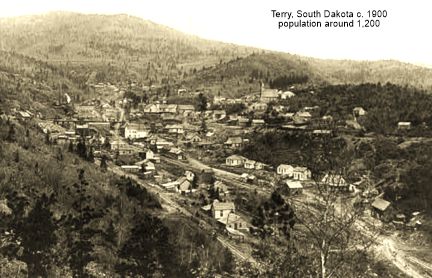|
Undergrad to medical school
Fred had entered the university in October, 1903
following undergraduate work at the University
of Michigan in Ann Arbor, MI where he attended
with his older brother, Emmert Leaton.
Fred expected to graduate from medical school in
1905. Fred had been born in Carroll county,
Missouri and relocated with his family as a boy
to western South Dakota in the village of Terry
in the Black Hills area. He was the son of
William H. Leaton (1855–1921) and Selma Fischer
Leaton (1852–1927) with two brothers and a
fiancé, Hannah Blatchford (1878–1952), nicknamed
Effie.* William Leaton worked as a
carpenter for Homestake Mining .
Fiancé
Effie Blatchford, was one of six children born to John (1853–1906) and
Elizabeth Treleven Blatchford (1854–1923) of Terry, SD, a village near Lead in the Black Hills. An 1879
immigrant from England, John was a superintendent in
a
Black Hills, SD company, Golden Reward Mining. One of Effie's siblings, Dr. John Blatchford jr., had
received his education at Rush Medical. In 1901 Effie had completed school in Racine, WI and went to
work as a stenographer and typist at the Smead Hotel in Lead, SD.


|
 |
Theater companions?
It is possible Fred went alone to the theater.
It seems more likely he had at least one
companion that for some reason went unmentioned
in newspapers. I can imagine three possible reasons
for the omission.
-
1.) Fred's theater companion may have been
Vernon Hodges himself who wanted to avoid the stigma of having survived
while his friend did not.
-
2.) Fred's companion was his fiancé who feared condemnation from her small hometown.
Effie's sister Edith had married six weeks earlier and honeymooned for "several weeks" in Chicago. Did
Effie join her sister and new brother-in-law in Chicago, affording Effie and Fred the opportunity to spend verboten
unchaperoned time together? In Chicago
that wouldn't have been noteworthy but in
Terry, SD with its population of 1,200, Aunt
Bee's nosy friends might have disapproved.
-
3.) An appearance of
Infidelity. Fred's theater
companion may have been a female that wasn't
Effie. If so, Hodges may well have
known it, and would also have appreciated
the humiliation for Fred's fiancé and family
back in South Dakota community if publicized.
Concealment would have been the gentlemanly
thing to do. Hodges and Leaton traveled
together on long train rides to and from the
Black Hills and Chicago several times from
1900 to 1903, allowing ample time for
conversation and sharing of confidences.
The pair shared a unique bond as young men
with prosperous futures from tiny South
Dakota communities, experiencing one of the
world's most energetic and exciting cities
of their time. They were close enough
friends that Hodges knew Leaton had gone to
the Iroquois Theater the afternoon of the
fire.
Bringing Fred home
His younger brother, John Leaton (1882–1917), a resident of
Omaha, traveled to Chicago and with Hodges escorted Fred's body home to South Dakota. Effie's father met them in Nebraska. Not much
doubt that the three men discussed Fred's theater companion and presented a unified front when they reached South Dakota.
The service was conducted at the Methodist
Episcopalian church in Terry, SD by reverend Daniel
W. Tracy. Newspapers in Terry and Lead reported the service was attended by everyone in town. Burial was at the Masonic cemetery in
Lead, CO.
A member of a Lead, CO Mason's lodge, the fraternal organization handled
the funeral arrangements, with assistance from the
Knights of Pythias, where Frederick was also a
member.
In the years after the fire
Five months after the fire Effie entered the Missouri Commercial School,
presumably to learn secretarial skills. Her
fifty-one-year-old father died of suicide three
years later, a response to health problems. In
1908 she married John Griffin (1879–1945) a miner as
her father had been. They had one child, a son
named Dan (1908–1982). The family moved around
over the next twenty years, living in Montana,
Nebraska and California. It wasn't the life
Effie would have led as a doctor's wife but maybe
similar to that of her childhood.
Vernard Hodges went on to have the life Fred
might have had. He returned to Lead, SD and joined the hospital
staff there. He married in 1908 and served in World War I. He
had three children; his two sons served in World War
II.
|
